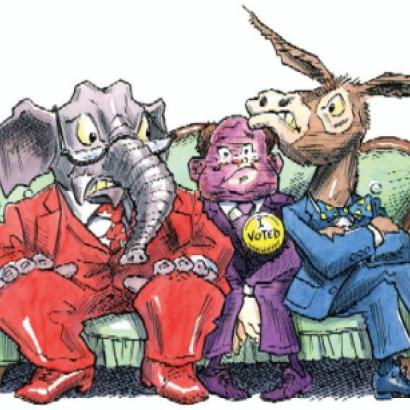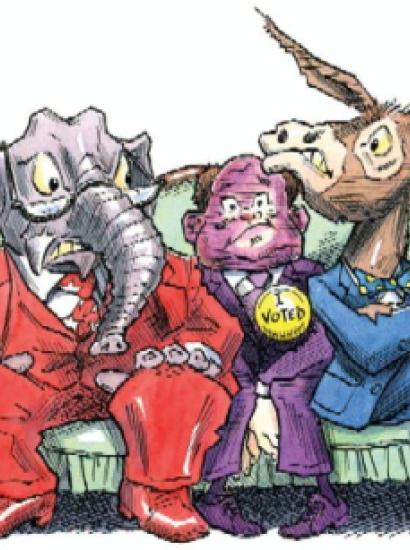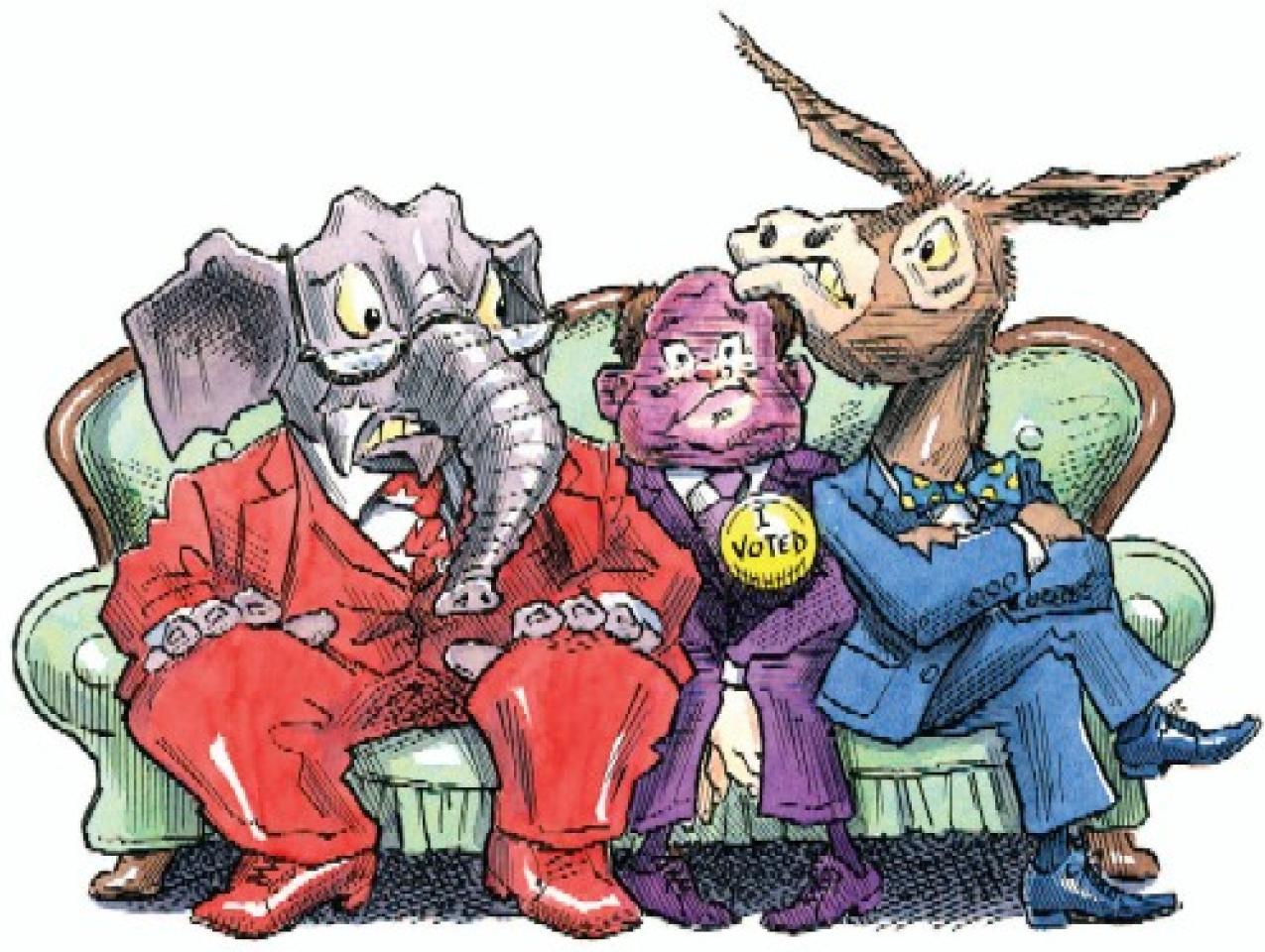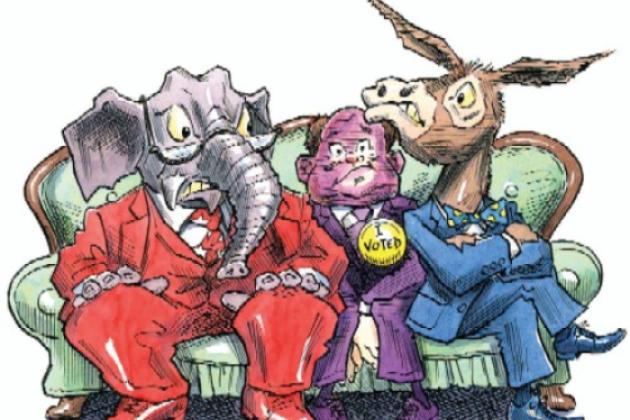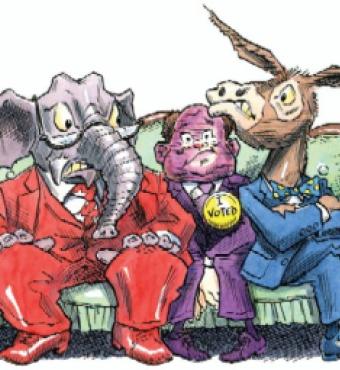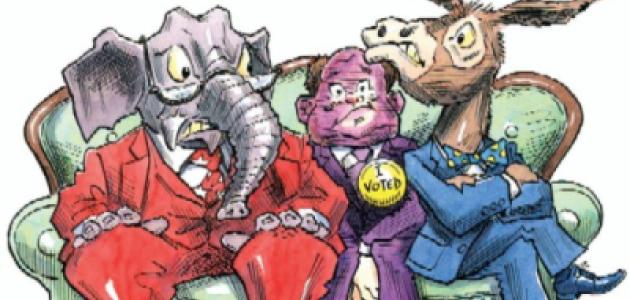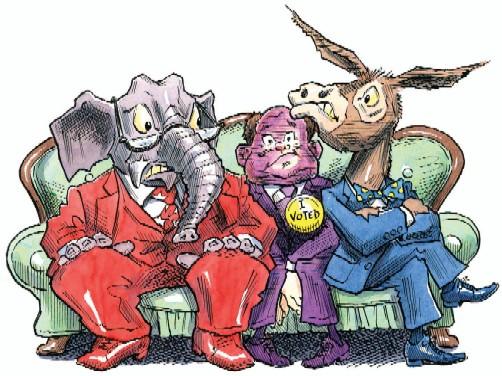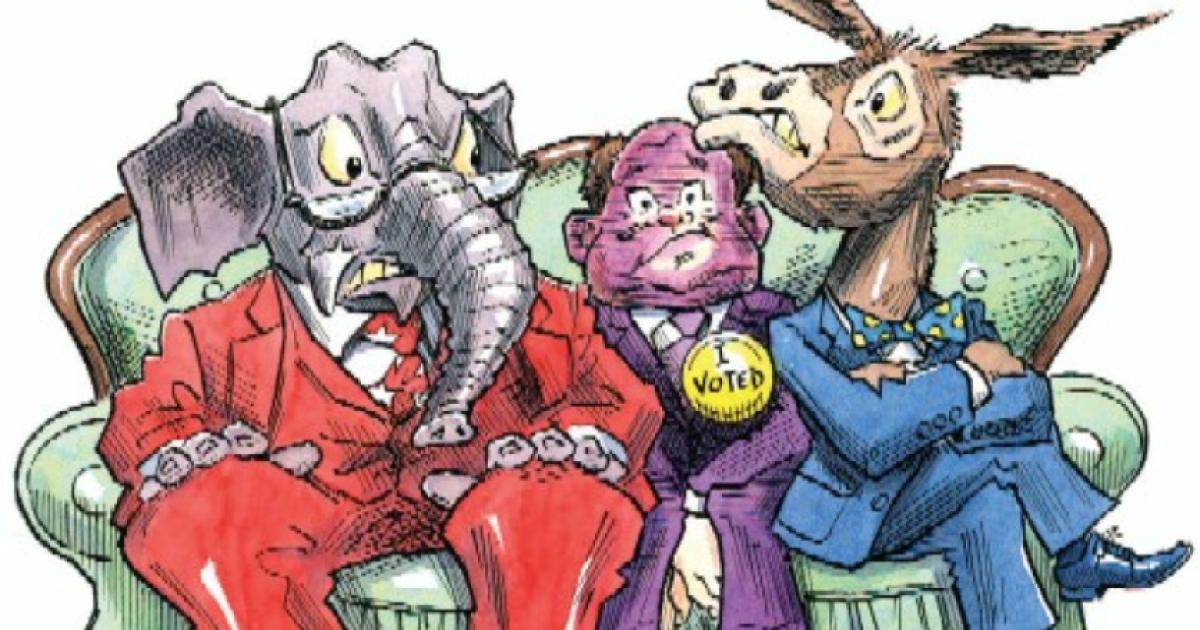- Campaigns & Elections
- The Presidency
- Law & Policy
- Civil Rights & Race
- Politics, Institutions, and Public Opinion
“There is a religious war going on in this country, a cultural war as critical to the kind of nation we shall be as the Cold War itself, for this war is for the soul of America.”— Pat Buchanan at the 1992 Republican Convention
“Listen to what the red-state citizens say about themselves, the songs they write, and the sermons they flock to. They know who they are—they are full of original sin and they have a taste for violence. The blue-state citizens make the Rousseauvian mistake of thinking humans are essentially good, and so they never realize when they are about to be slugged from behind.”— Jane Smiley after the 2004 election
During the long decade between pundit Pat Buchanan’s declaration of war and novelist Jane Smiley’s cry of anguish, the notion that America had split into two bitterly opposed political camps became as commonplace as apple pie. The once United States had divided into the red (Republican) states versus the blue (Democratic) states. Americans now voted on the basis of religion and moral values, rather than economics and foreign policy. Political moderates had disappeared, ceding the field to staunch liberals and conservatives. Swing voters similarly had vanished, leaving only die-hard partisans to cast ballots.
The developments seemed to threaten the very stability of our country. E .J. Dionne Jr., writing in 2003 in the Washington Post, observed that “the red states get redder, the blue states get bluer, and the political map of the United States takes on the coloration of the Civil War. . . . Up in heaven, Abe Lincoln must be shaking his head in astonishment. The country he sought to keep united is pulling apart politically, and largely along the same lines that defined Honest Abe’s election victory in 1860.”
As a political scientist who has studied the matter, however, I think Lincoln can rest easy. An examination of the facts doesn’t support America’s image of itself as a polarized nation, riven by a culture war. Americans are closely divided but not deeply divided. We split evenly in elections, not because we are bitterly opposed camps but because we instinctively seek the center while parties and candidates hang out at the extremes.
| Consider abortion. Only 30 percent of Democrats believe it should be “legal under all circumstances,” and only 30 percent of Republicans believe it should always be illegal. Large pluralities of both parties prefer the middling option of “legal only under certain circumstances.” |
Pundits often compare the sociological characteristics of red and blue states, contrasting the proportions of gun owners, born-again Christians, and the like. Such contrasts are striking, but deceiving, because their correlation with political choices is far from perfect: Upward of 35 percent of gun owners voted for John Kerry in 2004, as did a similar proportion of born-again Christians. Public opinion surveys that compare the policy views of red-state and blue-state residents show that they do not differ nearly as much as commonly presumed.
Although the size of majorities varies, in general the majority of red-staters and blue-staters are on the same side of an issue. In 2004, for example, a narrow majority of red-state residents joined a larger majority of blue-state residents who favored making gun regulations stricter. Solid majorities of blue-state residents share red-state residents’ support for the death penalty and opposition to gay marriage. Political differences? Yes. A cultural chasm? No.
The conventional interpretation of the 2004 election held that voters concerned about “moral values” decided the election. The phrase came from a single poorly framed exit-poll question. In fact, studies show that voters’ feelings about gay marriage and abortion had little or nothing to do with the outcome. The election hinged primarily on concerns about homeland security and leadership. If one wished to credit a single group with reelecting President Bush, it would not be evangelical Christians, who made up about the same proportion of the electorate in 2004 as in 2000 and who voted for Bush at about the same rate as in 2000. Rather, the group to credit or blame would be American women, whose 4- to 5-percentage-point swing to Bush between 2000 and 2004 accounts for virtually all of his 2.4 percent popular vote margin.
| We split evenly in elections not because we are bitterly opposed camps but because we instinctively seek the center while parties and candidates hang out at the extremes. |
Moderate voters have not disappeared. According to Gallup Poll data, Americans classify themselves ideologically in about the same way as they have since the 1970s: Between 15 to 20 percent identify as liberal, 40 to 45 percent as moderate, and 35 to 40 percent as conservative. (Liberal denizens of the Bay Area may be distressed to learn that they are so badly outnumbered by conservatives, but it’s nothing new.) Moreover, many people who adopt ideological labels hold positions on specific issues that are seemingly at odds with the abstract labels they choose. Ongoing research by political scientists Christopher R. Ellis and James A. Stimson reports that only one-fifth of self-classified conservatives held consistently conservative views on both social and economic issues. About one-third were consistent social but not economic conservatives, and about one-sixth were consistent economic but not social conservatives. One-third of self-classified conservatives were neither consistent social nor economic conservatives on specific issues. Small wonder that President Bush’s proposal to introduce private accounts into Social Security went nowhere.
Swing voters have not disappeared. Voters remain loyal to their party or defect from it depending on the choices they are offered. Between Bush and Kerry in 2004, there were few swing voters—just as there were few between Ronald Reagan and Walter Mondale 20 years earlier. Voters had had four years to take a good look at a president who governed from the right. His opponent was a Massachusetts liberal. So what was there to be uncertain about? By contrast, millions of Americans who never wavered in their choice between Bush and Kerry freely crossed party lines when it came to other offices and ballot propositions. Twenty-two states have governors of the party opposite their presidential choice in 2004. Montanans in 2004 voted for Bush and a Democratic governor—and passed both a medicinal marijuana initiative and a gay marriage prohibition by large margins. In 2006, more than 750,000 Californians who voted for Republican Governor Arnold Schwarzenegger did not vote for Republican Tom McClintock, one line lower on their ballots, for lieutenant governor.
Why do a large number of smart, well-informed people persist in thinking that the country is deeply divided? A variety of misconceptions underlie the distorted picture of U.S. politics.
| Abraham Lincoln can rest easy. The facts show that America is not a polarized nation, caught up in a red-blue war of culture. Americans are closely divided but not deeply divided. |
One reason is that the political parties have become more distinct. Although the aggregate distributions of the ideological positions and issue stances held by Americans remain essentially centrist and have changed little over the years, Democrats and Republicans have sorted themselves out more clearly. The Republican Party has shed much of its liberal wing, especially in the Northeast. The Democratic Party has shed much of its conservative wing, especially in the South. The result is that an average Republican and an average Democrat differ more from each other than they did a generation ago. (Such comparisons, of course, ignore the 35 to 40 percent of Americans who classify themselves as political independents.)
Still, it is easy to exaggerate the extent of party differences. In research for his doctoral thesis, Matthew Levendusky documented in great detail that not all Democrats are liberals and not all Republicans conservatives. The parties have become more distinct on some issues than on others; and on some issues one of the parties has become more internally divided, not united.
Consider abortion, an issue often viewed as a defining difference between Democrats and Republicans. Gallup data indicate that only about 30 percent of self-identified Democrats believe that abortion should be “legal under all circumstances” and only about 30 percent of Republicans believe abortion should be “illegal in all circumstances.” Large pluralities of both parties prefer the middle option of “legal only under certain circumstances.” According to the 2004 National Election Study, 23 percent of Americans who classified themselves as strong Republicans said that abortion should always be legal, compared to 22 percent who said that it should never be legal.
Why do such findings surprise? Because our picture of American politics usually reflects an unrepresentative political class. Officeholders, interest-group leaders, political infotainers, and issue activists—people in these roles constitute a political class that often represents the public face of politics in America.
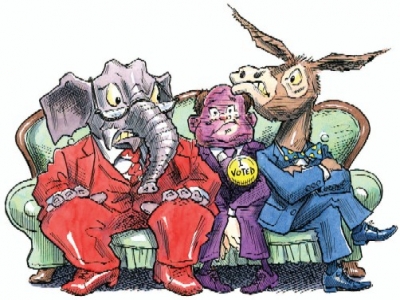
While numbering in the millions, the political class is nevertheless a small and unrepresentative slice of an American public that numbers more than 200 million eligible voters. This public is not terribly interested in most political issues and consequently is not well informed about them. In contrast, the political class is deeply interested and informed (although its information may be biased). Television does not cover the tens of millions of ordinary Americans who are busy earning their livings and raising their families; rather, television covers the charges and countercharges of the political class.
This media focus distorts our picture of politics because, as research shows, the political class differs from the public in three important ways. First, its members hold more extreme positions than do ordinary people. Republican and Democratic members of the political class are much more deeply divided on issues than their fellow party members in the larger public. They reject compromises that the rank and file would accept.
Second, the issues that motivate the political class are often different from those of most concern to the general public. Polls consistently show that public concern focuses on broad national issues—the war in Iraq, homeland security, education, health care, and the like. Hot-button issues that get a lot of press often fall low on a list of public concerns. For example, despite all the furor about gay marriage, a study of the 2004 voting by Sunshine Hillygus, an assistant professor of government at Harvard, reported that gay marriage ranked 15 on a list of 16 issues in electoral importance. (Only tort reform ranked lower.) Thus, the political class deflects the political agenda away from the broad concerns of the public and toward issues that primar-ily concern small and unrepresentative minorities.
Finally, members of the political class engage in behavior that would be unacceptable in most other spheres of American life. Too often they are loud, disrespectful, vituperative—in a word, uncivil. We raise our children not to behave like this. I have considerable sympathy for columnist Matthew Miller’s comment that “alienation is the only intelligent response to a political culture that insults our intelligence.”
In thinking about polarization, it’s essential to remember that voters’ political choices are different from their political positions. At the time of the 2004 election, Democrats overwhelmingly disapproved of Bush and voted for Kerry, whereas Republicans overwhelmingly approved of Bush and voted for him. Evidence suggests that voters’ positions have not changed; if their voting seems polarized it must be the alternatives that have changed. Whether people approve of the president depends not only on what they would like him to do, but also on what he already has done. Whether you love him or loathe him, the simple fact is that President Bush is (to reverse his self-description) a divider, not a uniter. Here in California, when offered a more moderate choice, many Democrats who would not have considered voting for Republican Bush in 2004 were willing to vote for Republican Arnold Schwarzenegger in 2005. Similarly, nonstandard Republican candidates like John McCain and Rudy Giuliani have the potential to scramble voting alignments in 2008 even if voters do not change their underlying positions.
| Members of the political class are too often loud, disrespectful, vituperative—in a word, uncivil. We raise our children not to behave like this. |
Political historians tell us that American political development is irregular: Long periods of relative stability are interrupted by periods of rapid change in political issues and voting alignments. The 1930s saw the collapse of a dominant Republican coalition under the pressures of economic distress; the 1960s saw the disruption of the New Deal coalition as race and a costly war split the Democratic Party, and as social and economic changes brought new issues and patterns of thinking into politics. Republicans again became the dominant presidential party and extended their control into Congress in the 1994 elections.
My sense today is that we may be approaching another point where change is imminent. A new generation has grown up, one for whom the old battles of the 1960s seem no more relevant than the Great Depression did to my generation. The Cold War is over, and we are struggling to formulate national security policies for a new era. Many Americans are uncertain about aggressive Bush administration policies and simultaneously uncertain that Democrats are tough enough to meet contemporary threats. Many Americans realize that enormous fiscal challenges lie ahead as baby boomers age and make major demands on Social Security and Medicare, but both parties treat such impending problems as issues to be campaigned about rather than problems to be solved. The same is true for health care. Democrats substitute ideology for evidence in social policy, while Republicans substitute religion for science in health and environmental policy. The political system seems strangely disconnected from the country.
Under such conditions pressure builds and eruptions occur. Parties fissure between old-guard and maverick factions, and wild cards like George Wallace and Ross Perot come out of nowhere, surprising the political establishment and upsetting old equilibriums. Perhaps we are building toward such a flash point.








